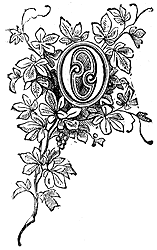 |

N the borders of Moor Park are the ruins of the once celebrated Waverley Abbey.
They stand in a large green meadow, round which the river Wey winds on three sides, overshadowed by low wooded hills. It is just such a valley as the Cistercian Monks were wont to prefer to heights.
It was the first monastery of the White, or Cistercian Monks in England, and was built by William Giffard, Bishop of Winchester, who brought twelve monks and their abbot to it in 1128, from the Abbey of Eleemosyna, in Normandy. It soon began to receive gifts of granges and manors, and in about fifty years it had seventy brothers in it, and a hundred and twenty lay brethren. It kept also about thirty ploughs always at work. King John persecuted them for their wealth, and the monks had to disperse and fly; but they soon returned, and on St Thomas's Day, 1230, they entered in procession their new church, which had been thirty years building, and was opened that day.
The annals (or chronicle) kept in this abbey were published in Gale's Hist. Anglicanae Scriptores. They begin in 1066 and end in 1291, and are very interesting. Waverley colonised several abbeys in the south, from Kent to Devonshire; but at the Dissolution it was not a very rich abbey, though it had a fairly good income of £174 8s. 3 1/2 d. It was granted by Henry to his treasurer, Sir W. Fitzwilliam.
The precincts of this abbey had the full privilege of sanctuary, the same as if the applicant clung to the altar, and they held tenaciously to this right, of which a singular instance is given in their annals.
During the abbacy of Bishop Giffard in 1240, a young man offered himself as shoemaker to the fraternity, and was received into the abbey; but in the August following, some officers of justice appeared and arrested him on a charge of murder. In vain the monks and their abbot represented that the man was in sanctuary; the officers carried off their prisoner The abbot and monks, greatly alarmed by this invasion of their privileges, agreed not to hold any divine services in the abbey till the wrong done it had been righted. The abbot was deputed to go and represent the facts to the Pope's Legate, who then happened to be in England. The Legate heard, but - all circumstances considered - refused to interfere. The abbot then proceeded to the king (Henry III.), demanded the punishment of his officers for violating sanctuary, and craved the return of the prisoner.
The Lords and councillors of Henry, however, interfered, and insisted that the abbot should first remove the interdict on his abbey, and produce his charters and muniments that the case might be thoroughly examined and considered. The bishop complied, and his charter being examined, it was found that the Abbey had the right of sanctuary he claimed, and his petition was at once granted. The suspected murderer was restored to the monks; the officers were condemned to ask pardon of Holy Church and to be whipped at the gate of the monastery. This sentence was executed by the Dean of the Abbey and the Vicar of Farnham. The poor men were then absolved and dismissed.
It is to be hoped that the monks believed the culprit not guilty of the charge against him; but no such motive, we may be sure, inspired their action. They only sought to protect the rights of sanctuary, which gave them so much power, and of which this incident shows the injurious side.
In cases where sanctuary would have saved an innocent political applicant for it, it was often found powerless, as. for example in the case of poor little Prince Richard of York, and of Perkin Warbeck. both of whom were removed from sanctuary against their own will or that of their guardians.
Of the existing remains of the abbey there is a fairly perfect vaulted crypt of the early English character. Near it is the solitary wall of a room, with three lancet windows in it; this, it is thought, may have been the refectory. Trees and ivy overshadow the remaining pieces of wall, and grow in and out of them, so close to the river that the abbey must have suffered from inundations whenever it overflowed its banks.
It is a tradition of the neighbourhood that there is concealed treasure in the ground, but no trace of it has ever been found.
The gardens of the abbey were once some of the most productive in England, the wall-fruit being especially fine and abundant.
|
 |